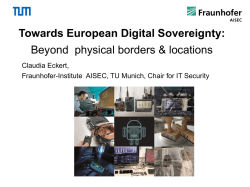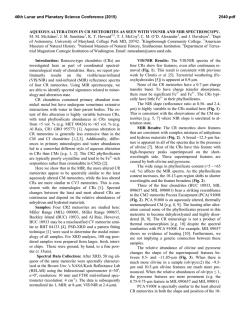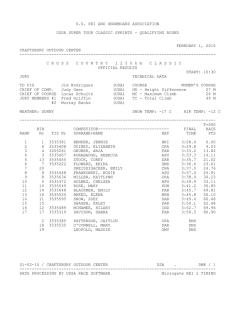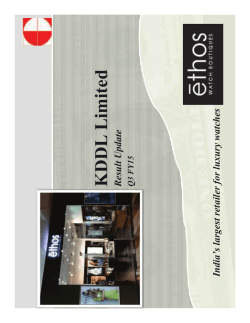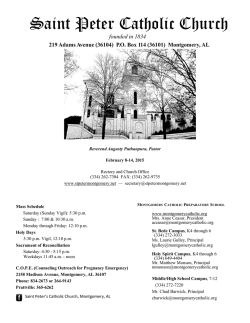
Inter-Root: A New Self-Governed Architecture for DNS Root Zone
Inter-Root: A New Self-Governed Architecture for DNS Root Zone Resolution Binxing Fang Xiaohua Chen June,2015 1 “State Network Sovereignty”is now a consensus among the international society 20. State sovereignty and international norms and principles that flow from sovereignty apply to State conduct of ICT-related activities, and to their jurisdiction over ICT infrastructure within their territory. In June 24, 2013,the UN published A/68/98 file: Report of the Group of Governmental Experts on Developments in the Field of ICT in the Context of International Security. 2 Fundamental Features of State Sovereignty 4 Fundamental Features: Jurisdiction: to make legal decisions and judgments by oneself Self-defense:to defend the well-being of oneself Equality:to be NOT subordinate to others Independence:the existence does not depend on others 3 Network Sovereignty The Internet within one country cannot exist independently due to the DNS architecture Almost every visit to any server in the Internet needs to use directly or indirectly the root name servers to resolve the server domain name, unless the IP address of the server is known. The root name servers could be utilized to disable the Internet within a country. This power is in the hand of the owner of root name servers, which is currently the ICANN / the US government. 4 Current DNS Architecture Root servers, responsible for the root zone and TLD resolutions, are the start point of resolution and the center of structure • Namespace, represented by a label tree • Authority Server hieratical Distributed Database recursive resolver • Lots of caching • Resolution protocol . (roo t) cn com cu 1 foo 2 www 3 Recursive Resolver 5 Root Zone Management NTIA delegated IANA function to ICANN and VeriSign Any change in the root zone needs to be approved by the US government root zone file TLD operator 12 Root Server Operators (US 9、EU 2、Japan 1) 13 logical root servers and hundreds of mirrors 6 “Disappearing Threat” Independence The ccTLD of a country could be removed from the root zone database, so that the ccTLD is erased from the namespace,and the names under the ccTLD cannot be resolved. As reported, .iq (Iraq) in 2003 and .ly (Libya) in 2004 temporarily cannot be resolved. R (roo t) ly U com cn 1 foo 2 www Disappearing Li I by 我 a . 3 China Recursive Resolver 7 “Blindness Threat” Independence Recursive resolvers within a country could be denied to the resolution service by the root servers, so that the users in that country cannot access the Internet. As reported, Somalia has been denied by the root servers So ma li a R 根 (roo t) so U 你 com cn 1 foo 2 www Blindness I . 3 China Recursive Resolver 8 “Isolation Threat” Independence . The network of a country may be completely isolated, so that any name resolution traffic via international gateways will be interrupted. (roo t) cu cn com 1 foo 2 www Isolation Cuba I R 根 Ch U in 你 a 3 Domestic recursive resolver Foreign recursive9 resolver Threats in the current DNS China 我 I Disappearing R Cuba U Edit the root zone file Very Easy Edit the ACL Easy Physically isolate the country Not Easy Blindness China I R 根 U 你 Isolation China I R 根 Cuba Cuba U 你 10 Related Work Under 3 Threats Difficult to counteract the disappearing threat,because root zone data still comes from IANA. All solutions are sort of root mirrors in essence Open root Universal root Recursive root Fake root Alternative root Disappearing Blindness Isolation ☐ ☐ ☐ ☐ ☐ ☐ ☐ 11 Idea of Decentralizing Root Zone Principle:maintain the logic structure with a single root,construct the system structure with multiple roots • Names remain unique and humanunderstandable • Root zone governance and operation are decentralized 12 Inter-Root : A New Self-Governed Resolution Architecture for DNS Root Zone 1, Establish Country Root Servers (CRSes) • • • CRS:country self-governed public root server CRS provides root zone resolution, independent with current root server operators CRS may use IANA root zone file;In emergency, CRS safeguards the root zone resolution for the country 2, Establish‘Inter-Root’among CRSes • • • Inter-Root:a system of interconnected CRSes Inter-Root is established among countries,providing the root zone information exchanges among the countries In emergency,countries joining Inter-Root may provide resolution service for each other 13 Mesh Structure in Inter-Root CRS adopts IANA root zone file .CN CN root .NET .COM IANA .GOV .CU TLD info exchange CU root Reciprocal resolution service between countries RU root .RU UK root .UK DE root .DE 14 Increments on current DNS Namespace • Replicate ccTLD info in CRS Authority server • • New CRS which coexists with current root servers Reciprocal resolution service for emergency response system Recursive resolver • Add CRS info in root hint Resolution protocol • None 15 Features of Inter-Root Independence • Root zone resolution service is self-governed • Resolution service within a country is self-governed Openness • • Inter-Root is open to any country joining or withdrawing CRS is open to all recursive resolvers Compatibility • Inter-Root is about name resolution,not domain delegation • Inter-Root is transparent to resolvers not using any CRS Scalability • • Inter-Root inherits the scalability of current DNS The number of countries in Inter-Root is about 200 at most 16 Significance of Inter-Root Country DNS security enhanced Recursive resolvers freely choose either CRS, or original root servers. Using CRS gets additional protection from their own government. Strategic deterrent against 3 threats Inter-Root provides a strategic deterrent that if a ccTLD is erased from the IANA root zone, then those countries concerning the threats will join Inter-Root. This supports the concept of “network sovereignty”. Demonstrate Sovereignty Equality In the first World Internet Conference, Chairman Xi Jinping said: “China is willing to work together with other countries in the world, in the spirit of mutual respect and trust. We together deepen international cooperation, respect for the sovereignty of the network, maintain network security, and build a peaceful, secure, open and cooperative network. We hope to establish a multilateral, democratic, transparent international Internet governance system". 17 Thanks 18
© Copyright 2026

